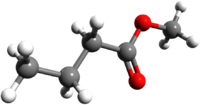This is an old revision of this page, as edited by ImageRemovalBot (talk | contribs) at 22:55, 29 August 2011 (Removing links to deleted file File:Methyl butyrate.png). The present address (URL) is a permanent link to this revision, which may differ significantly from the current revision.
Revision as of 22:55, 29 August 2011 by ImageRemovalBot (talk | contribs) (Removing links to deleted file File:Methyl butyrate.png)(diff) ← Previous revision | Latest revision (diff) | Newer revision → (diff)
| |
| Names | |
|---|---|
| IUPAC name Methyl butanoate | |
| Identifiers | |
| CAS Number | |
| 3D model (JSmol) | |
| ECHA InfoCard | 100.009.812 |
| RTECS number |
|
| CompTox Dashboard (EPA) | |
SMILES
| |
| Properties | |
| Chemical formula | C5H10O2 |
| Molar mass | 102.13 g/mol |
| Appearance | Colourless liquid |
| Density | 898 kg/m³ |
| Melting point | -95 °C (178K) |
| Boiling point | 102 °C (375K) |
| Solubility in water | 1.5 g/100 mL (22 °C) |
| Refractive index (nD) | 1.386 |
| Hazards | |
| NFPA 704 (fire diamond) |
 |
| Flash point | 12 °C |
| Except where otherwise noted, data are given for materials in their standard state (at 25 °C , 100 kPa).
| |
Methyl butyrate, also known under the systematic name methyl butanoate, is the methyl ester of butyric acid. Like most esters, it has a fruity odour, in this case resembling apples or pineapples. At room temperature, it is a colourless liquid with low solubility in water, upon which it floats to form an oily layer. Although it is flammable, it has a relatively low vapour pressure (40mm Hg at 30 °C (86 °F)), so it can be safely handled at room temperature without special safety precautions.
It is present in small amounts in several plant products, especially pineapple oil. It can be produced by distillation from essential oils of vegetable origin, but is also manufactured on a small scale for use in perfumes and as a food flavouring.
Methyl butanoate has been used in combustion studies as a surrogate fuel for the larger fatty acid methyl esters found in biodiesel. However, studies have shown that, due to its short-chain length, methyl butanoate does not reproduce well the negative temperature coefficient (NTC) behaviour and early CO2 formation characteristics of real biodiesel fuels. Therefore, methyl butanoate is not a suitable surrogate fuel for biodiesel combustion studies.
References
- Merck Index, 13th Edition
- Aldrich Chemicals Handbook, Sigma-Aldrich Company, Milwaukee, (2007)
- Flath, Robert A.; Forrey, R. R. (1970). "Volatile components of Smooth Cayenne pineapple". Journal of Agricultural and Food Chemistry. 18 (2): 306–309. doi:10.1021/jf60168a018.
- Use of methyl butyrate as an additive in perfume
- Methyl butyrate as a component of biodiesel
- A wide-ranging kinetic modeling study of methyl butanoate combustion